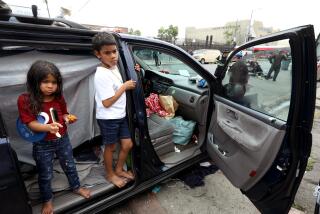Volunteers’ Healing Hands Aid Ailing Children Across Border
- Share via
Three-year-old Myrna Guardado didn’t seem to understand all the fuss being made over her.
Myrna was resting in bed, surrounded by adults who dangled toys and dolls. Her hospital room at St. Joseph Medical Center in Burbank was crowded with flowers and more toys.
A couple of days before, Myrna had been brought to the medical center from her home in Rosarito Beach, Mexico. She had undergone an intense, three-hour operation to remove part of what doctors called a mole that covered about 25% of her body. The rare affliction could have led to skin cancer had it not been treated.
To completely remove the birth defect, Myrna will be brought back to St. Joseph twice a year for the next three years.
Myrna’s treatment, including more operations and skin grafting, would have totaled well over $100,000, hospital officials said. But St. Joseph is not charging her family for the treatment and resultant hospital stays.
Seriously Ill
The operations are part of a special volunteer program where doctors from St. Joseph and other Southern California hospitals donate their services to Clinica de Esperanza Infantil , a children’s clinic in Rosarito Beach. The more seriously ill are taken from Mexico to area hospitals across the border, including St. Joseph.
Physicians at St. Joseph were captivated by Myrna’s delicate features and courage. Myrna smiled a little after the first operation but seemed largely oblivious to the attention of medical personnel.
“She’s nervous now because she’s away from home,” said Dr. Ronald Ritz, the plastic and reconstructive surgeon who supervised the operation. “Someday she’ll appreciate what’s being done. Everyone feels so good that they’ve actually been able to do something.”
Myrna was first seen by doctors at the clinic about 15 miles south of Tijuana. Clinica de Esperanza Infantil means Clinic of Hope for Children.
The clinic, donated by the area’s governing body, is in a small complex operated by retired businessman Victor Jones of Burbank, who also has a home in Rosarito Beach. Jones runs the clinic through donations and volunteers.
The clinic is poorly equipped and overrun with patients on the one Saturday a month it is open, Jones acknowledged.
“On a scale of one to 10, we’re about a two in terms of modern facilities,” Jones said. “When we opened two years ago, we were only seeing about five kids a day. Now it’s never less than 50, and sometimes as much as 100 each day.”
Jones has made arrangements with several area hospitals to obtain help. Doctors from Huntington Memorial Hospital in Pasadena and UCLA Medical Center, as well as St. Joseph, donate their time to assist him.
“These doctors have been our salvation,” Jones said.
Brought Back
Ritz has been periodically making the pilgrimage to the clinic for about seven years. He said he has brought many children back with him for treatment.
“There’s a fulfillment you get from doing this that you can’t get anyway else,” he said. “Help is really needed there.”
When children need more extensive treatment, Jones obtains authorization from the Immigration and Naturalization Service to bring them across the border.
Doctors from St. Joseph take equipment and medicine with them when they make the trek to Mexico. They leave some of the equipment behind at the clinic.
While Myrna was recovering, another patient of Clinica de Esperanza Infantil , 17-year-old Wilfredo Chavez of Michoacan, Mexico, was recuperating in another part of St. Joseph.
Chavez was afflicted with a shrunken esophagus--the tube that leads from the throat to the stomach. The esophagus was the diameter of a straw, and Chavez had not been able to eat solid food for most of his life, said Dr. Neal Hamel, a physician who specializes in chest surgery.
Starving to Death
Chavez’s mother had had to liquefy all her son’s foods for the last several years, Hamel said. The teen-ager was in danger of slowly starving to death, he said.
“I felt bad when I saw all my friends eating hamburgers and tacos and I couldn’t eat,” Chavez said in Spanish as he sat on his hospital bed.
At St. Joseph, Hamel constructed a new esophagus from parts of Chavez’s stomach. After a few weeks, Chavez was able to eat tacos and enchiladas, foods he had never been able to enjoy.
The entire operation and hospital stay could have cost as much as $25,000, Hamel said. But Chavez’s family did not have to pay a cent.
“People need this kind of work, and I’m happy to do it,” Hamel said. “I enjoy seeing them get well.”
More to Read
Sign up for Essential California
The most important California stories and recommendations in your inbox every morning.
You may occasionally receive promotional content from the Los Angeles Times.











